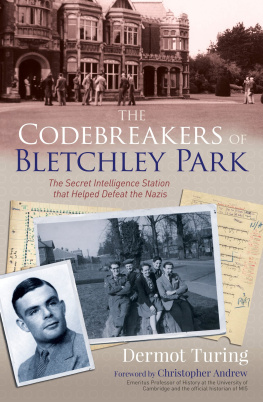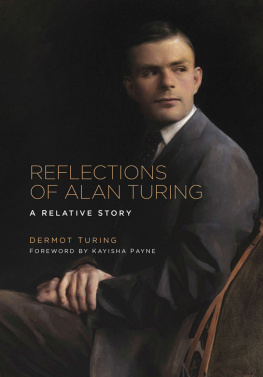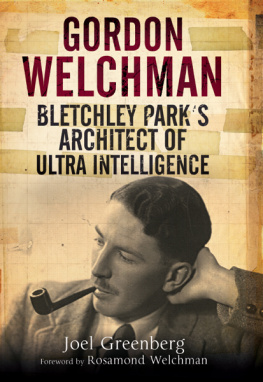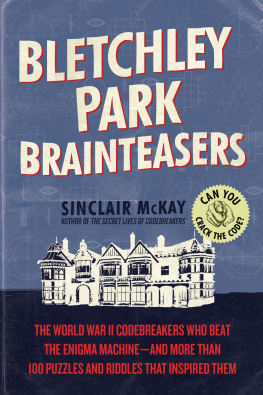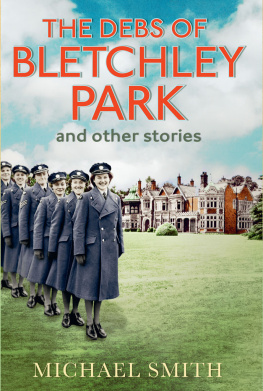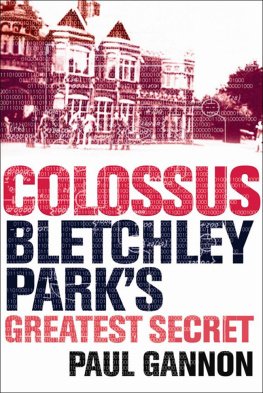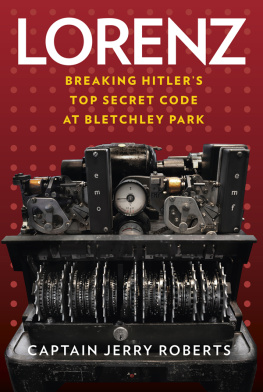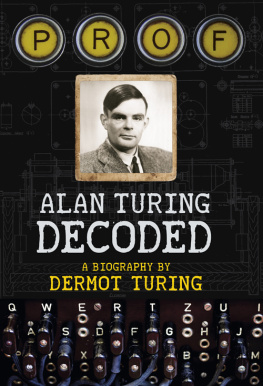John Dermot Turing - The Codebreakers of Bletchley Park: The Secret Intelligence Station that Helped Defeat the Nazis
Here you can read online John Dermot Turing - The Codebreakers of Bletchley Park: The Secret Intelligence Station that Helped Defeat the Nazis full text of the book (entire story) in english for free. Download pdf and epub, get meaning, cover and reviews about this ebook. year: 2020, publisher: Arcturus Digital Limited, genre: Non-fiction. Description of the work, (preface) as well as reviews are available. Best literature library LitArk.com created for fans of good reading and offers a wide selection of genres:
Romance novel
Science fiction
Adventure
Detective
Science
History
Home and family
Prose
Art
Politics
Computer
Non-fiction
Religion
Business
Children
Humor
Choose a favorite category and find really read worthwhile books. Enjoy immersion in the world of imagination, feel the emotions of the characters or learn something new for yourself, make an fascinating discovery.
- Book:The Codebreakers of Bletchley Park: The Secret Intelligence Station that Helped Defeat the Nazis
- Author:
- Publisher:Arcturus Digital Limited
- Genre:
- Year:2020
- Rating:4 / 5
- Favourites:Add to favourites
- Your mark:
- 80
- 1
- 2
- 3
- 4
- 5
The Codebreakers of Bletchley Park: The Secret Intelligence Station that Helped Defeat the Nazis: summary, description and annotation
We offer to read an annotation, description, summary or preface (depends on what the author of the book "The Codebreakers of Bletchley Park: The Secret Intelligence Station that Helped Defeat the Nazis" wrote himself). If you haven't found the necessary information about the book — write in the comments, we will try to find it.
John Dermot Turing: author's other books
Who wrote The Codebreakers of Bletchley Park: The Secret Intelligence Station that Helped Defeat the Nazis? Find out the surname, the name of the author of the book and a list of all author's works by series.
The Codebreakers of Bletchley Park: The Secret Intelligence Station that Helped Defeat the Nazis — read online for free the complete book (whole text) full work
Below is the text of the book, divided by pages. System saving the place of the last page read, allows you to conveniently read the book "The Codebreakers of Bletchley Park: The Secret Intelligence Station that Helped Defeat the Nazis" online for free, without having to search again every time where you left off. Put a bookmark, and you can go to the page where you finished reading at any time.
Font size:
Interval:
Bookmark:
Less than half a century ago, Bletchley Park remained probably the best-kept major secret in British history. Its members, in Churchills now famous phrase, were the geese that laid the golden eggs, but never cackled. Even at the end of the war, when most returned to civilian life, they were firmly reminded that they must keep their wartime work completely secret for the rest of their lives even from close family and friends
Bletchleys post-war successor, GCHQ, feared, however, that some of the clues to the wartime ULTRA intelligence derived from breaking Enigma and other high-grade enemy ciphers were too obvious for alert historians of the war to miss. It was common knowledge that British cryptanalysts had broken German ciphers during World War I; indeed one German decrypt the 1917 Zimmermann telegram had made front-page news on both sides of the Atlantic and may even have hastened American entry into the War.
The published 19456 hearings of the Congressional Joint Committee on the Investigation of the Pearl Harbor Attack also revealed in great detail US decryption of Japanese diplomatic telegrams before the attack and the White Houses knowledge of them. So it was difficult for GCHQ to understand why, for thirty years, no historian publicly posed the rather obvious question of whether German ciphers had been broken in World War II as well as in World War I.
Most Oxbridge Colleges and many other universities had historians or other academics who had worked at Bletchley and knew the answer to the unasked question. When I first became assistant lecturer at Cambridge in 1967, quite a number were colleagues in the History and neighbouring faculties. The Codebreakers of Bletchley Park brings them vividly back to life. Among our friends and neighbours in Newnham were three couples who had met and married at Bletchley Park: Harry and Hilary Hinsley, Christopher and Helen Morris, Patrick and Sydney Wilkinson.
In their lectures and talks before the mid-1970s, when the ULTRA Secret was at last officially acknowledged, none made any reference not merely to Bletchley Park but to any other example of signals intelligence (Sigint), the interception and decryption (if necessary) of signals and other communications. Even the word Sigint remained taboo. When I gave a paper in 1970 to Harry Hinsleys international relations seminar on French codebreaking during the Third Republic, he felt bound to use the formula what Christopher Andrew refers to as Sigint, when commenting on it.
When I began teaching a course on intelligence history at Cambridge, I used to remind students that, at their age, some of their World War II predecessors had been working at Bletchley rather than studying for a degree. Harry Hinsley was recruited at the age of twenty after only two years as an undergraduate reading history. Alan Stripp, with whom he later edited the first book of Bletchley reminiscences, was younger still; he was an eighteen year-old first-year classics scholar at Trinity College when recruited as a codebreaker in 1942.
The only previous occasion when such young recruits had a major role in British intelligence was in the reign of Queen Elizabeth I, whose intelligence chief, Sir Francis Walsingham, an alumnus of Kings College, Cambridge, recruited a series of talented Cambridge students from his former university including the twenty-one-year-old Christopher Marlowe in 1585. Probably none of those engaged in breaking Hitlers ciphers at Bletchley Park, knew that Walsinghams main codebreaker, Thomas Phelippes, probably a graduate of Trinity College, broke the ciphers of Philip II of Spain before the Armada (though some of the historians may have known that he broke those of Mary Queen of Scots). Walsingham told Phelippes that he would not believe in how good part [the Queen] accepteth of your service; she awarded him a royal pension.
Gender historians almost invariably ignore intelligence history. They are wrong to do so. The first British government department to break the glass ceiling was MI5 in 1992 when, with the appointment of Stella Rimington as DG, it became the first major intelligence agency anywhere in the world with a female head. As far back as the beginning of World War I, the decision by MI5s then non-graduate male hierarchy to recruit secretarial staff from two Oxford womens colleges, Royal Holloway College (also female) and Cheltenham Ladies College made MI5 the first official agency with a minority of women who were better educated and from families higher up the social scale than most of their male colleagues.
The list compiled in March 1939 by the first head of Bletchley Park, Alastair Denniston, of 73 academics (men of the professor type) suitable for wartime work at Bletchley Park included only two women. Though their numbers increased steadily and 75% of Bletchley staff were women by 1945, codebreaking was officially classed as a male occupation. As Sir Dermot Turing shows, female codebreakers had therefore to be given misleading titles such as clerical staff or translator. Some of their talents, such as those of Alison Fairlie, were fully exploited. Those of a number of other female translators, however, were not. Miriam Rothschild, later DBE, FRS and one of Britains leading scientists, seems to have been given limited scope for her remarkable range of talents. Her brother Victor Rothschild, also a future FRS, was given a much more important role in MI5.
Like MI5 and SIS (also known as MI6), Bletchley Park was penetrated by Soviet intelligence in the person of John Cairncross, the Fifth Man of the Cambridge Five. Cairncross was at Bletchley for only a year and not the only source of Sigint obtained by Soviet intelligence in Britain. But for Frank Birch, one of the most remarkable of the Codebreakers of Bletchley Park, Soviet penetration would have been far worse. Birch was a veteran World War I codebreaker who returned to Sigint at the outbreak of the Second, after spending most of the 1930s acting on stage and screen. Birch rose to become Deputy Director of GCHQ at the end of the war before returning to acting in 1946.
In 1940 Birch was responsible for interviewing his fellow Cambridge graduate, Kim Philby, a Soviet agent since 1934, who was seeking a job at Bletchley Park. According to Philby, Birch rejected him, despite his fluent German, on the infuriating ground that he could not offer enough money to make it worth my while. Philbys explanation is unconvincing. Very few, if any, of those at Bletchley Park joined because of the salary it offered. It is far more likely that Birch distrusted him. Excluded from Bletchley, Philby, with help from his Cambridge contemporary and fellow Soviet agent, Guy Burgess, found a job in SIS, where, for more than a decade, he provided so much intelligence that Moscow sometimes found difficulty in coping with it. Had Birch admitted him, he would no doubt have tried to do the same at Bletchley Park.
Christopher Andrew
When the story of Bletchley Park and its achievements during World War II first reached the public in the mid-1970s, there was remarkably little discussion of the codebreakers who had made the place what it was. Frederick Winterbothams book, The Ultra Secret, sold over four million copies without a single mention of Alan Turing. The first biography of Alan Turing, published in 1959, did not mention Bletchley Park, partly because it was still a secret, but mainly because the biographer, Alan Turings mother (and my grandmother) had nothing except her own speculations to go on concerning what Bletchley Park had been about and her sons job there.
Slowly, over the next 15 years or so, some of the details of the story were filled in. Documents were released into the National Archives, and it became possible to learn about the operational impact of the intelligence generated by Bletchley Park. Later, the technical breakthroughs which had mechanized codebreaking, leading to a generation of proto-computers, captured the imagination. Yet none of those stories were about the people who populated Bletchley Park. Admittedly, in the earliest days, when there were still restrictions on revealing the technical details, the now-retired codebreakers penned their memoirs and wrote about the eccentric boffins with whom they worked; later on, when the Bletchley Park site itself opened as a museum, the surviving veterans predominantly the girls and young women who had worked on the machinery at Bletchley and its outstations had their turn at telling their personal stories.
Font size:
Interval:
Bookmark:
Similar books «The Codebreakers of Bletchley Park: The Secret Intelligence Station that Helped Defeat the Nazis»
Look at similar books to The Codebreakers of Bletchley Park: The Secret Intelligence Station that Helped Defeat the Nazis. We have selected literature similar in name and meaning in the hope of providing readers with more options to find new, interesting, not yet read works.
Discussion, reviews of the book The Codebreakers of Bletchley Park: The Secret Intelligence Station that Helped Defeat the Nazis and just readers' own opinions. Leave your comments, write what you think about the work, its meaning or the main characters. Specify what exactly you liked and what you didn't like, and why you think so.

